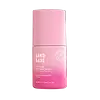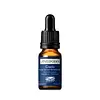What's inside
What's inside
 Key Ingredients
Key Ingredients

 Benefits
Benefits

 Concerns
Concerns

 Ingredients Side-by-side
Ingredients Side-by-side

Water
Skin ConditioningCaprylic/Capric Triglyceride
MaskingGlycolic Acid
BufferingAlpha-Glucan Oligosaccharide
Cleansing1,2-Hexanediol
Skin ConditioningPropanediol
SolventSodium Hydroxide
BufferingPotassium Cetyl Phosphate
EmulsifyingBakuchiol
AntimicrobialPolyacrylate Crosspolymer-6
Emulsion StabilisingGlycerin
HumectantPolymnia Sonchifolia Root Juice
Skin ConditioningCetyl Palmitate
EmollientMaltodextrin
AbsorbentCaprylyl Glycol
EmollientAcrylates/C10-30 Alkyl Acrylate Crosspolymer
Emulsion StabilisingChondrus Crispus Extract
Skin ConditioningParfum
MaskingT-Butyl Alcohol
PerfumingLactobacillus
Skin ConditioningBiosaccharide Gum-1
HumectantAcronychia Acidula Fruit Extract
HumectantDavidsonia Pruriens Fruit Extract
AntioxidantSyzygium Luehmannii Fruit Extract
AntioxidantBenzyl Alcohol
PerfumingLithothamnion Calcareum Extract
Skin ConditioningSodium Levulinate
Skin ConditioningSodium Hyaluronate
HumectantGlyceryl Caprylate
EmollientSodium Anisate
AntimicrobialDehydroacetic Acid
PreservativeWater, Caprylic/Capric Triglyceride, Glycolic Acid, Alpha-Glucan Oligosaccharide, 1,2-Hexanediol, Propanediol, Sodium Hydroxide, Potassium Cetyl Phosphate, Bakuchiol, Polyacrylate Crosspolymer-6, Glycerin, Polymnia Sonchifolia Root Juice, Cetyl Palmitate, Maltodextrin, Caprylyl Glycol, Acrylates/C10-30 Alkyl Acrylate Crosspolymer, Chondrus Crispus Extract, Parfum, T-Butyl Alcohol, Lactobacillus, Biosaccharide Gum-1, Acronychia Acidula Fruit Extract, Davidsonia Pruriens Fruit Extract, Syzygium Luehmannii Fruit Extract, Benzyl Alcohol, Lithothamnion Calcareum Extract, Sodium Levulinate, Sodium Hyaluronate, Glyceryl Caprylate, Sodium Anisate, Dehydroacetic Acid
Water
Skin ConditioningAloe Barbadensis Leaf Juice
Skin ConditioningGlycerin
HumectantLactobacillus Ferment
Skin ConditioningBambusa Vulgaris Leaf Extract
Skin ConditioningBakuchiol
AntimicrobialSodium Hyaluronate
HumectantLeuconostoc/Radish Root Ferment Filtrate
AntimicrobialSaccharomyces/Xylinum/Black Tea Ferment
Skin ConditioningPersea Gratissima Oil
Skin ConditioningTocopherol
AntioxidantGlycine Soja Seed Extract
Skin ConditioningHelianthus Annuus Seed Oil
EmollientCitric Acid
BufferingMannitol
HumectantMaltodextrin
AbsorbentXanthan Gum
EmulsifyingSclerotium Gum
Emulsion StabilisingPotassium Sorbate
PreservativeSodium Benzoate
MaskingPropanediol
SolventDehydroacetic Acid
PreservativeBenzyl Alcohol
PerfumingCI 77163
Cosmetic ColorantCI 77891
Cosmetic ColorantCI 77491
Cosmetic ColorantCI 77492
Cosmetic ColorantCI 77499
Cosmetic ColorantMica
Cosmetic ColorantParfum
MaskingLinalool
PerfumingGeraniol
PerfumingWater, Aloe Barbadensis Leaf Juice, Glycerin, Lactobacillus Ferment, Bambusa Vulgaris Leaf Extract, Bakuchiol, Sodium Hyaluronate, Leuconostoc/Radish Root Ferment Filtrate, Saccharomyces/Xylinum/Black Tea Ferment, Persea Gratissima Oil, Tocopherol, Glycine Soja Seed Extract, Helianthus Annuus Seed Oil, Citric Acid, Mannitol, Maltodextrin, Xanthan Gum, Sclerotium Gum, Potassium Sorbate, Sodium Benzoate, Propanediol, Dehydroacetic Acid, Benzyl Alcohol, CI 77163, CI 77891, CI 77491, CI 77492, CI 77499, Mica, Parfum, Linalool, Geraniol
Ingredients Explained
These ingredients are found in both products.
Ingredients higher up in an ingredient list are typically present in a larger amount.
Bakuchiol is a plant-derived antioxidant (it's vegan!). It is often called the replacement for retinol although it is not part of the same family.
It has similar effects as retinol: skin smoothing, reducing discoloration, and preventing wrinkles. It does not cause as much irritation as traditional retinoids.
Bakuchiol works by breaking down free radicals and stimulating collagen production in skin.
Combining bakuchiol with retinol will not have adverse side effects. Studies show using them will just boost the benefits. Bakuchiol is also found to help stabilize retinol.
While bakuchiol does not make the skin more sun sensitive, we recommend wearing SPF on a daily basis.
Read more about traditional retinol
Learn more about BakuchiolBenzyl Alcohol is most commonly used as a preservative. It also has a subtle, sweet smell. Small amounts of Benzyl Alcohol is not irritating and safe to use in skincare products. Most Benzyl Alcohol is derived from fruits such as apricots.
Benzyl Alcohol has both antibacterial and antioxidant properties. These properties help lengthen the shelf life of products. Benzyl Alcohol is a solvent and helps dissolve other ingredients. It can also improve the texture and spreadability.
Alcohol comes in many different forms. Different types of alcohol will have different effects on skin. This ingredient is an astringent alcohol.
Using high concentrations of these alcohols are drying on the skin. They may strip away your skin's natural oils and even damage your skin barrier. Astringent alcohols may also irritate skin.
Other types of astringent alcohols include:
According to the National Rosacea Society based in the US, you should be mindful of products with these alcohols in the top half of ingredients.
Any type of sanitizing product will have high amounts of alcohol to help kill bacteria and viruses.
Learn more about Benzyl AlcoholDehydroacetic Acid is fungicide and bactericide. It is used as a preservative in cosmetics. Preservatives help elongate the shelf life of a product.
Dehydroacetic Acid is not soluble in water.
Glycerin is already naturally found in your skin. It helps moisturize and protect your skin.
A study from 2016 found glycerin to be more effective as a humectant than AHAs and hyaluronic acid.
As a humectant, it helps the skin stay hydrated by pulling moisture to your skin. The low molecular weight of glycerin allows it to pull moisture into the deeper layers of your skin.
Hydrated skin improves your skin barrier; Your skin barrier helps protect against irritants and bacteria.
Glycerin has also been found to have antimicrobial and antiviral properties. Due to these properties, glycerin is often used in wound and burn treatments.
In cosmetics, glycerin is usually derived from plants such as soybean or palm. However, it can also be sourced from animals, such as tallow or animal fat.
This ingredient is organic, colorless, odorless, and non-toxic.
Glycerin is the name for this ingredient in American English. British English uses Glycerol/Glycerine.
Learn more about GlycerinMaltodextrin is a polysaccharide. It is derived from starch such as rice, corn, wheat, or potato starch.
In food, Maltodextrin is used to improve the texture and thicken a product. Due to its structure, it can help create a gel texture. As an emulsion stabilizer, it helps keep the ingredients in a product together.
As a polysaccharide, Maltodextrin has moisturizing properties. Polysaccharides are a type of carbohydrate. The top layer of skin uses polysaccharides to retain water, keeping the skin hydrated.
Maltodextrin is water soluble and has a sweet taste.
Learn more about MaltodextrinParfum is a catch-all term for an ingredient or more that is used to give a scent to products.
Also called "fragrance", this ingredient can be a blend of hundreds of chemicals or plant oils. This means every product with "fragrance" or "parfum" in the ingredients list is a different mixture.
For instance, Habanolide is a proprietary trade name for a specific aroma chemical. When used as a fragrance ingredient in cosmetics, most aroma chemicals fall under the broad labeling category of “FRAGRANCE” or “PARFUM” according to EU and US regulations.
The term 'parfum' or 'fragrance' is not regulated in many countries. In many cases, it is up to the brand to define this term.
For instance, many brands choose to label themselves as "fragrance-free" because they are not using synthetic fragrances. However, their products may still contain ingredients such as essential oils that are considered a fragrance by INCI standards.
One example is Calendula flower extract. Calendula is an essential oil that still imparts a scent or 'fragrance'.
Depending on the blend, the ingredients in the mixture can cause allergies and sensitivities on the skin. Some ingredients that are known EU allergens include linalool and citronellol.
Parfum can also be used to mask or cover an unpleasant scent.
The bottom line is: not all fragrances/parfum/ingredients are created equally. If you are worried about fragrances, we recommend taking a closer look at an ingredient. And of course, we always recommend speaking with a professional.
Learn more about ParfumPropanediol is an all-star ingredient. It softens, hydrates, and smooths the skin.
It’s often used to:
Propanediol is not likely to cause sensitivity and considered safe to use. It is derived from corn or petroleum with a clear color and no scent.
Learn more about PropanediolSodium Hyaluronate is hyaluronic acid's salt form. It is commonly derived from the sodium salt of hyaluronic acid.
Like hyaluronic acid, it is great at holding water and acts as a humectant. This makes it a great skin hydrating ingredient.
Sodium Hyaluronate is naturally occurring in our bodies and is mostly found in eye fluid and joints.
These are some other common types of Hyaluronic Acid:
Learn more about Sodium HyaluronateWater. It's the most common cosmetic ingredient of all. You'll usually see it at the top of ingredient lists, meaning that it makes up the largest part of the product.
So why is it so popular? Water most often acts as a solvent - this means that it helps dissolve other ingredients into the formulation.
You'll also recognize water as that liquid we all need to stay alive. If you see this, drink a glass of water. Stay hydrated!
Learn more about Water